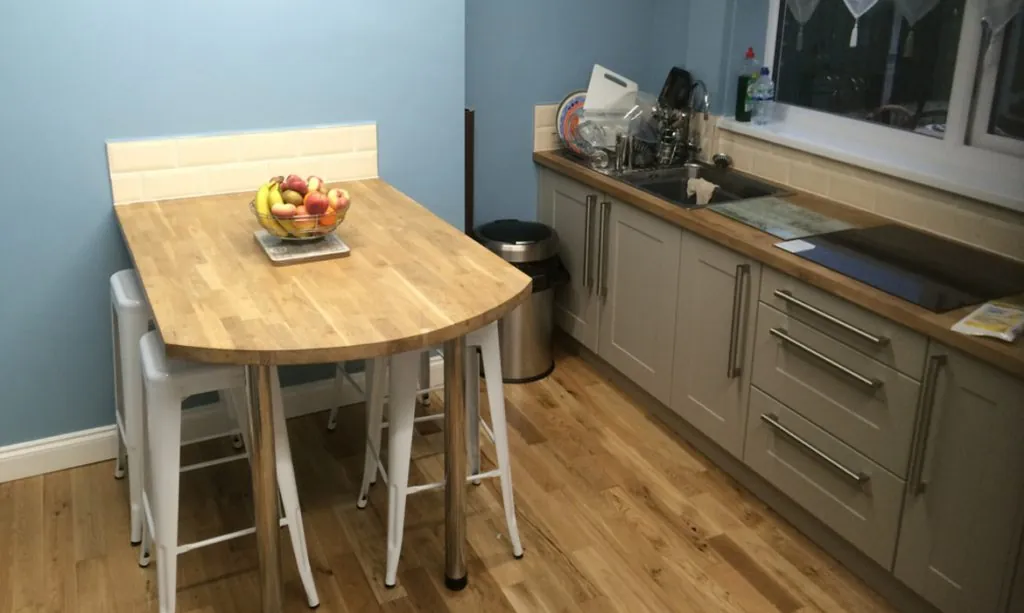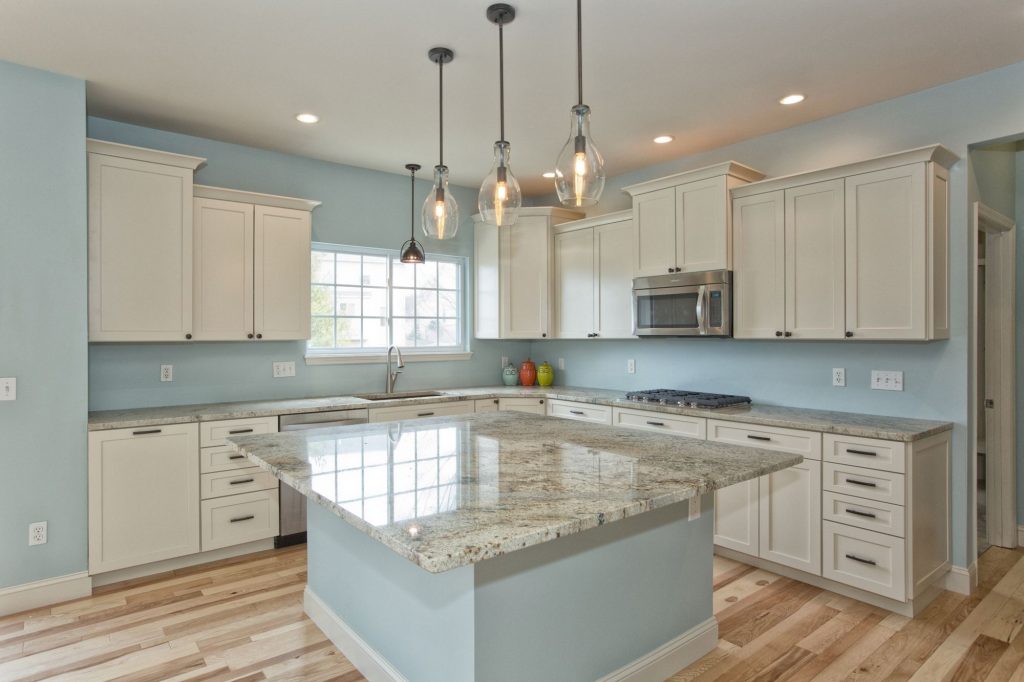Choosing the best kitchen worktop for your project can be a daunting task. With a huge range of materials and a great range of prices, it’s important to understand exactly what’s on offer so that you can make the best choice for your needs. Our guide to kitchen worktops in 2018 is designed to introduce you to some of the most popular materials out there, to help you make an informed decision about what’s right for you.
The best kitchen worktop materials
The sky really is the limit when it comes to the best kitchen worktop materials. Modern kitchen worktops can be made of a variety of different substances, all with their own pros, cons and suitability. Think about your own kitchen, the challenges you face, as well as your budget of course, and pick a beautiful kitchen worktop that will fulfil all your needs.
Hardwood
- Used best in: Food prep areas including islands, breakfast bars and around the sink.
- Looks best in: A variety of kitchen styles. Despite being a traditional material, when used with modern materials like steel or glass can create warmth in your contemporary theme.
- Pros: Wood worktops improve with age, some are naturally water resistant and, when cared for properly, will last a lifetime
- Cons: Hardwoods can be expensive, and all wood worktops require care and maintenance to keep them looking their best. They won’t withstand heat from hot pans and cutting should not be done directly on the surface.
- Care and maintenance: Avoiding heat, standing water and sharp objects is crucial, and as well as this daily care, a certain amount of longer term maintenance will need to be done. This can include sanding out scratches or stains, as well as oiling to maintain its water resistance.
Granite
- Used best in: Anywhere; this material can withstand heat and water, so is suitable even around the sink and next to the hob.
- Looks best in: Both traditional and modern kitchen styles will benefit from a granite worktop. It’s a luxurious choice that never goes out of fashion.
- Pros: Granite worktops are long lasting and unlikely to go out of style, are easy to clean and highly hygienic as a result and offer strength and durability even against hot pans.
- Cons: The biggest downside of granite worktops is that they are heavy. The weight of a large granite worktop may mean the supporting cabinets require extra strengthening. Also, if they do become damaged, they cannot be repaired.
- Care and maintenance: Granite is a very low maintenance material, requiring little more than a simple wipe down with a damp cloth and detergent on a day to day basis. However, some types of granite are porous and therefore will require re-sealing every couple of years.
Composite quartz
- Used best in: Suitable for use everywhere, even around the hob and sink.
- Looks best in: Again, any kitchen. One of the most desirable things about quartz composite is that it can be manufactured in a huge range of colours. Dramatic dark greys and blues can look striking in a contemporary kitchen setting, whereas cream or other neutral colours will look excellent in a more traditional setting.
- Pros: Composite is highly customisable, with lots of colours and textures to choose from. They require hardly any maintenance and are built to last.
- Cons: Unlike granite, this material is not entirely heat resistant, so you’ll need to use trivets for your pans. They are somewhat expensive compared to other options.
- Care and maintenance: Avoid placing hot things directly on the surface to prevent discolouration, but other than that a simple wipe over is all they require. No sealing or additional maintenance is needed.
Stainless steel
- Used best in: Around the sink and the hob and in places where you’ll be preparing food.
- Looks best in: Industrial styled kitchens or contemporary schemes where other colours and textures have been used to soften the look.
- Pros: Stainless steel is non-porous which means it’s one of the most hygienic materials there is. These worktops are easy to install and will last a long time.
- Cons: If you’re not used to working with stainless steel surfaces, they can be a little noisy to use. They can also become dented if things are dropped on them or scratched.
- Care and maintenance: Stainless steel worktops should include the addition of chromium which will make them resistant to rust, so no long-term maintenance is required. If they start to look dull, a wipe over with a little baby oil is all that’s required to bring them back to shiny glory.
Corian
- Used best in: Sink and wet areas, which can be moulded in one smooth, seamless piece for an ultra-modern look.
- Looks best in: Any kitchen where you require a unique or challenging design or some out of the ordinary colour. Modern kitchen designs can be kicked up a notch with a unique Corian worktop.
- Pros: Highly design flexible, super hygienic and resistant to bacteria and available in one long sheet. Nothing is quite as customisable as Corian, from colour to shape to the inclusion of special features, your imagination can run wild.
- Cons: Expensive compared to other solid surface worktops, and not as heat resistant as granite or quartz composite.
- Care and maintenance: Simple cleaning is enough to take care of your Corian worktop for most of its life. Standard degreaser and cleaning sprays will remove most marks and stains.
Glass
- Used best in: Breakfast bars or around the sink. It’s a great way to make a feature of a worktop to add light and shine.
- Looks best in: Modern kitchens with contemporary cabinets and décor.
- Pros: Highly durable and available in a variety of colour hues to suit your scheme. No chance for stains, bacteria or mould growth, so a very hygienic choice too.
- Cons: Can be heavy, so cupboards underneath may require strengthening. Can also be fairly expensive compared to other options and with enough pressure or a sudden impact is placed on them they can crack.
- Care and maintenance: Simple, common cleaning products will keep your glass worktop looking great. They do tend to attract dust and can show water marks quite badly, so will need regular cleaning with an evaporating product like a glass cleaner.
Laminate
- Used best in: Anywhere where you want the look of a new kitchen worktop without the expense and hassle of a more luxurious material. If sealed properly, this can be used successfully in wet areas. Do avoid direct heat contact though.
- Looks best in: Because laminate can mimic pretty much any other style of worktop, the sky is the limit, so whatever scheme you’re going for, you’ll find a kitchen worktop to match.
- Pros: Affordability is the big plus point here; laminate worktops are by far the cheapest option. They are waterproof and won’t stain and can be installed easily thanks to the simplicity of cutting to size.
- Cons: They don’t hold up to heat, so pans will need to be placed on trivets. The finish can be messy if you’ve got an under mounted or Belfast sink, and dropping sharp or heavy objects could leave a mark.
- Care and maintenance: It’s very low maintenance, only requiring standard types of cleaning with cloths and detergent. At this price, it’s better to replace it if it becomes shabby than to try and repair or renovate your worktop.
Picking the best kitchen worktops for your project is about more than just selecting the one that takes your fancy. You’ll need to consider the advantages and disadvantages of each, so that you can be confident you’re investing in the right way. Although some materials may be cheaper to purchase, they might not last as long as a more expensive choice, so think about how you use your kitchen to help you decide.
For more advice on the right kitchen worktop for your needs, get in touch with us today. Our experienced kitchen designers are on hand to discuss all the nitty gritty you’ll need to know, and to help you select the very best material to create the kitchen of your dreams.

